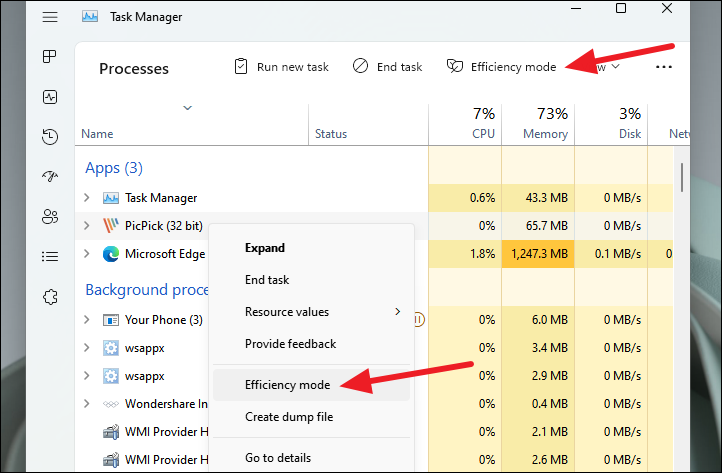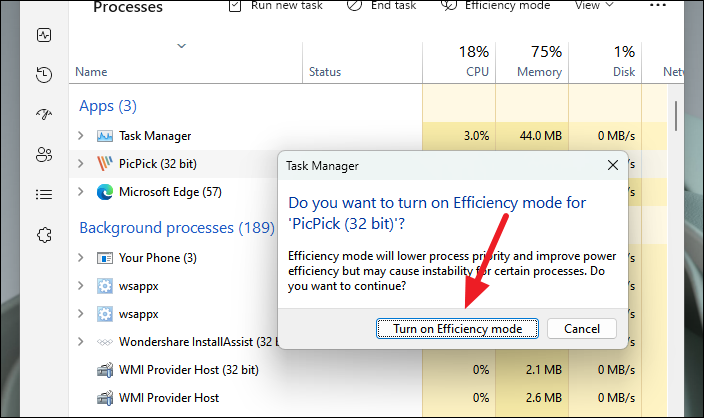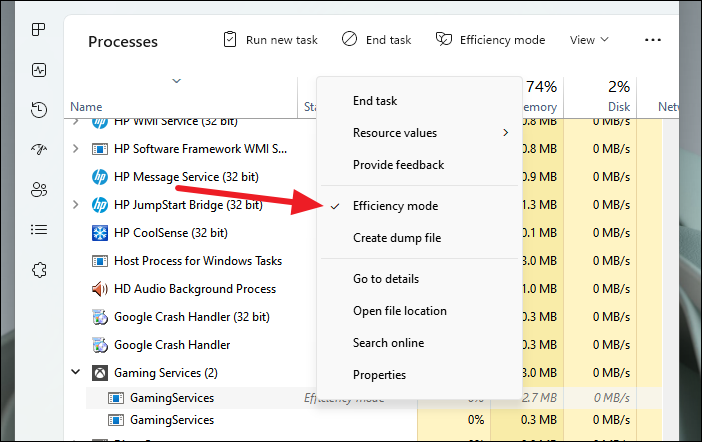In Windows 11, Microsoft has introduced several new features and enhancements, and the Task Manager is no exception. A notable addition is the Efficiency mode, which aims to optimize resource usage and improve system performance by adjusting how resources are allocated to applications and processes.
What is Efficiency mode in Task Manager?
Many of us have experienced situations where our computer isn't performing as well as it should. The system feels sluggish, and even simple tasks take longer than usual. Upon checking the Task Manager, we often find that certain processes are consuming excessive resources like CPU, memory, or disk usage, even when they're not actively in use.
Traditionally, we might end these resource-heavy processes to free up system resources. However, terminating processes can sometimes lead to instability or unexpected behavior. This is where the Efficiency mode in Windows 11's Task Manager offers a better solution. It allows users to limit the CPU resources that specific processes can use without stopping them entirely, leading to improved responsiveness for the applications you are actively using.
Moreover, background processes that consume significant resources can increase hardware strain, resulting in higher temperatures, increased fan noise, and reduced battery life over time. By using Efficiency mode, you can achieve better energy efficiency and extend your device's battery lifespan.
Efficiency mode also helps you identify applications that are already optimized for resource usage, providing insights into which apps are contributing to system efficiency. This feature aligns with Microsoft's commitment to sustainable software and enhancing user experience.
How does it work?
Efficiency mode gives users the ability to manage how system resources are allocated to certain processes. Currently, it focuses on optimizing CPU usage by utilizing a feature called EcoQoS (Eco Quality of Service). Since the CPU is often the most power-consuming and highly contested resource in modern devices, optimizing CPU usage can significantly improve system performance and power efficiency. Microsoft plans to extend these optimizations to other resources in future updates.
EcoQoS is a new Quality of Service level in Windows that adjusts the processor's configuration to enhance both performance and power efficiency. When you enable Efficiency mode for a process, two changes occur: the process's base priority is lowered to 'low', ensuring it doesn't compete with higher-priority tasks, and its QoS level is set to EcoQoS, allowing Windows to manage it in a way that balances power and performance optimally.
According to Microsoft, enabling Efficiency mode can result in a responsiveness improvement ranging from 14% to 76%, particularly in busy systems. It also reduces the CPU's thermal footprint by preventing it from overworking on background tasks, which contributes to a cooler, quieter system and potentially extends hardware longevity.

How to enable the Efficiency mode for an app or process
Step 1: Open the Task Manager on your Windows 11 computer. You can do this by pressing Ctrl + Shift + Esc on your keyboard or by using any other preferred method.
Task Manager in Windows 11 has a redesigned interface. The traditional tabs are now part of a navigation menu on the left side of the window, represented by a hamburger icon.
Step 2: From this menu, select 'Processes'. You can also choose the 'Details' tab if you need more granular control.
Step 3: Find the process for which you want to enable Efficiency mode. If the process is nested under a parent process, click the arrow icon ('>') next to the parent process to expand it and view the sub-processes.

Step 4: Select the specific process. Then, you have two options to enable Efficiency mode: click on the 'Efficiency mode' button at the top of the Task Manager window, or right-click the process and choose 'Efficiency mode' from the context menu.

Step 5: A confirmation dialog will appear, informing you that enabling Efficiency mode will lower the process priority and increase power efficiency, but it may cause instability for certain processes. Click 'Turn on Efficiency mode' to proceed.

Note: If the option for Efficiency mode is unavailable (grayed out) for a process, it means it's a core Windows process. You cannot enable Efficiency mode for these processes, as throttling them could affect system stability.

Upon enabling Efficiency mode, you will notice a leaf icon next to the parent process in the 'Status' column, similar to the icon displayed for sleeping tabs in Microsoft Edge. The child process will show 'Efficiency mode' next to it, indicating that the mode is active for that process.

To disable Efficiency mode for a process, right-click the child process and click on 'Efficiency mode' again to deselect it. The checkmark next to the option will disappear, indicating that Efficiency mode is no longer active for that process.

By utilizing Efficiency mode in Windows 11's Task Manager, you can optimize resource usage and enhance your system's responsiveness, especially when dealing with resource-intensive background processes.

